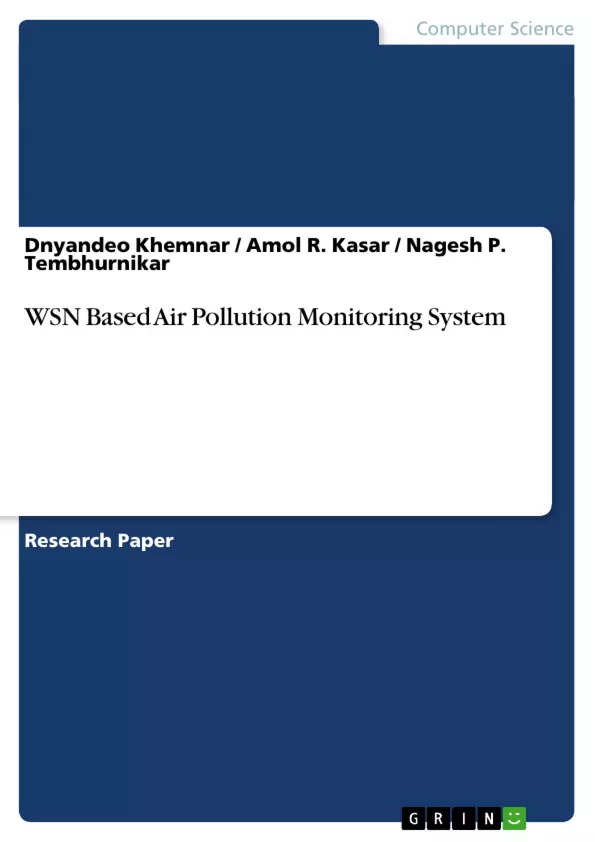Air pollution monitoring is extremely important as air pollution has a direct impact on human health and environment. In this paper we introduce a wireless sensor network system for participatory air pollution monitoring. The traditional air quality monitoring system, controlled by the Pollution Control Department, is extremely expensive. Analytical measuring equipment is costly, time and power consuming. In contrast to traditional air pollution monitoring stations, we present the design, implementation, and evaluation of low power, low cost WSN based Air Pollution Monitoring System which provides real time monitoring of polluted materials at proper locations by using distributed (real time) air pollution monitoring systems.
Inhaltsverzeichnis (Table of Contents)
- Introduction
- System Overview
- Proposed System
- Hardware Architecture
- ATMEGA16 microcontroller
- Sensors Array
- ZigBee Modules
- Central Server
- ZigBee Standard
- Air Quality
- Carbon Dioxide (CO2)
- Sulphur Dioxide (SO2)
- Nitrogen Dioxide (NO2)
- Air-Quality-Index
- Conclusion
- Acknowledgments
- References
Zielsetzung und Themenschwerpunkte (Objectives and Key Themes)
This paper presents the design, implementation, and evaluation of a low-power, low-cost Wireless Sensor Network (WSN) based Air Pollution Monitoring System. The system aims to provide real-time monitoring of air pollution levels at specific locations using a network of distributed sensors. The main objective of this project is to monitor air pollution, hazardous gases, and increase awareness about pollution by using an air pollution monitoring system.- Real-time monitoring of air pollution levels
- Cost-effective and low-power design of the WSN system
- Use of ZigBee network technology for communication
- Development of a pollution detection unit using an ATMEGA16 microcontroller
- Data aggregation and visualization for efficient analysis and reporting
Zusammenfassung der Kapitel (Chapter Summaries)
- Introduction: This chapter introduces the significance of air pollution monitoring, highlighting the impact on human health and the environment. It explains the limitations of traditional monitoring systems and the advantages of a WSN-based approach.
- System Overview: This chapter details the proposed WSN-based air pollution monitoring system, including its architecture and hardware components. It describes the functionality of each module, including the ATMEGA16 microcontroller, sensor array, ZigBee modules, and central server.
- ZigBee Standard: This chapter provides an overview of the ZigBee standard, its protocol stack, and network topologies. It emphasizes its suitability for low-power, low-data-rate wireless communication in sensor networks.
- Air Quality: This chapter discusses the different air pollutants that the system can measure, including Carbon Dioxide (CO2), Sulphur Dioxide (SO2), and Nitrogen Dioxide (NO2). It explains the formation and harmful effects of these pollutants. Additionally, it introduces the Air Quality-Index (AQI) and its role in evaluating air pollution levels.
Schlüsselwörter (Keywords)
Air Pollution, AtMega16 microcontroller, MG811 Sensor, MQ6 Sensor, MQ135 Sensor, Real Time, ZigBee, WSN. This work focuses on using a Wireless Sensor Network (WSN) for participatory air pollution monitoring. The system incorporates a range of sensors to monitor pollutants like Carbon Dioxide (CO2), Nitrogen Dioxide (NO2), and Sulphur Dioxide (SO2), enabling real-time data collection and analysis. The project leverages the ATMEGA16 microcontroller for data processing and communication through a ZigBee network. The key theme is the development of a cost-effective and efficient system for monitoring air quality, aiming to raise awareness and support governmental initiatives in pollution control.- Quote paper
- Dnyandeo Khemnar (Author), Amol R. Kasar (Author), Nagesh P. Tembhurnikar (Author), 2013, WSN Based Air Pollution Monitoring System, Munich, GRIN Verlag, https://www.grin.com/document/211609



